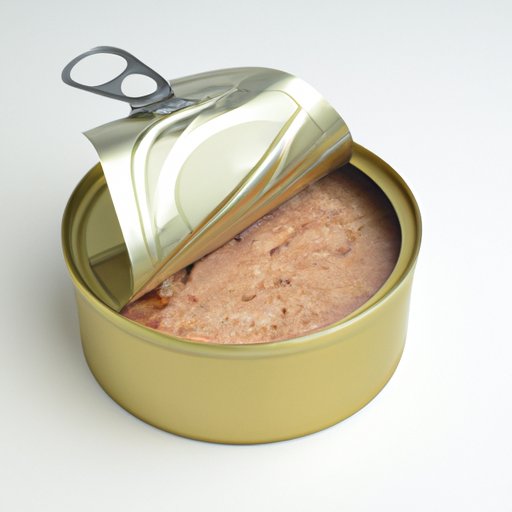
Introduction
Canned tuna is a popular food staple in many households due to its convenience, affordability, and versatility. However, there has been some debate about whether or not canned tuna is actually good for you. In this article, we’ll explore the nutritional benefits, safety concerns, and delicious recipes for incorporating canned tuna into a healthy diet.
The Nutritional Benefits of Canned Tuna: A Comprehensive Guide
Canned tuna is a rich source of protein, vitamins, and minerals. A 3-ounce serving of canned tuna in water contains about:
- 109 calories
- 23 grams of protein
- 1 gram of fat
- 0 grams of carbs
- 203% of your daily vitamin B12 needs
- 17% of your daily selenium needs
- Omega-3 fatty acids, which are beneficial for heart health
Canned tuna also contains other important vitamins and minerals, such as niacin, vitamin D, and potassium. Additionally, canned tuna is particularly useful for those with busy schedules, as it can be easily incorporated into salads, sandwiches, and pasta dishes.
Why Canned Tuna is an Affordable and Convenient Source of Protein
Not only is canned tuna a nutritious food choice, it’s also an affordable and convenient source of protein. For example, a 5-ounce can of tuna can cost as little as $0.69 and provide up to 20 grams of protein. Canned tuna is also versatile, as it can be used in a variety of dishes such as salads, casseroles, and sandwiches. Additionally, canned tuna is ideal for those looking to maintain a low-carb, high-protein diet as it contains virtually no carbohydrates.
Is Canned Tuna Safe to Eat? Everything You Need to Know
One concern that has been raised about canned tuna is the potential for mercury exposure. Mercury is a neurotoxin that can cause serious health problems, especially in infants, pregnant women, and children. However, the FDA has guidelines for how much canned tuna should be consumed to reduce the risks. They recommend that adults consume no more than 3-5 ounces of canned light tuna per week or no more than 6 ounces of canned albacore tuna per week.
In addition, the way tuna is canned and processed can also affect its safety. Canned tuna is cooked before being packaged, which helps to destroy some of the bacteria and viruses that might be present. However, if the can is damaged or punctured, bacteria can enter and grow. Therefore, it’s important to inspect cans of tuna before buying and to discard any cans that are damaged or have bulging lids.
Canned Tuna vs. Fresh Tuna: Which is Healthier?
Fresh tuna and canned tuna have similar nutritional benefits as both are good sources of protein, vitamins, and minerals. Fresh tuna also contains higher levels of omega-3 fatty acids and vitamin D than canned tuna, but it also carries a higher risk of mercury contamination. In fact, larger and older fish, such as fresh tuna, contain more mercury compared to smaller fish. By comparison, canned tuna contains lower levels of mercury compared to many other types of fish. It’s recommended to consume a variety of seafood and to check recommended levels of consumption to reduce mercury exposure.
Canned Tuna: A Healthy Go-To Meal for Busy People
Canned tuna is a great go-to option for a healthy meal that can be made in minutes. It can be incorporated into salads, casseroles, sandwiches, pasta dishes and more, making it ideal for people with busy schedules. Additionally, canned tuna can be used in many types of cuisine, including Asian and Mexican. However, it’s important to also consider the environmental impact of obtaining large amounts of canned tuna from overfished regions or improperly managed farms.
Canned Tuna and Mercury Levels: Separating Fact from Fiction
Mercury is an element that can be found in the ocean and can accumulate in the food chain. Tuna, being a predator fish, may contain higher levels of mercury. However, that shouldn’t be a reason to avoid it. When eaten in moderation, tuna is safe to consume. In addition, there are ways to reduce mercury exposure, such as draining the liquid from canned tuna or opting for smaller types of tuna such as skipjack. It’s also good to remember that there are always nutritional and environmental benefits derived from consuming other foods in addition to canned tuna.
5 Delicious and Nutritious Recipes for Canned Tuna
If you’re looking for easy, nutritious recipes that incorporate canned tuna, we’ve got you covered. Here are five delicious ideas:
- Tuna Salad with Avocado: Mix canned tuna with avocado, lemon juice, and diced vegetables such as celery and onion.
- Tuna Pasta Salad: Mix canned tuna with whole wheat pasta, baby spinach, cherry tomatoes and minced garlic.
- Tuna and White Bean Casserole: Mix canned tuna with cannellini beans, diced tomatoes, and a sprinkle of Parmesan cheese.
- Tuna Melt: Mix canned tuna with mayonnaise and sliced pickles. Spread on whole wheat bread and top with cheddar cheese. Broil until cheese is melted and bubbly.
- Sweet Potato Tuna Patties: Add drained canned tuna to mashed sweet potatoes, minced red onion, and cilantro. Form into small patties and either bake or pan-fry until golden brown.
Conclusion
Canned tuna can be a healthy and convenient addition to a balanced diet. It provides a good source of protein, vitamins, minerals and omega-3 fatty acids. Despite its many benefits, it is important to be aware of safety concerns, especially regarding mercury levels. By following recommended guidelines, draining liquid and inspecting cans before use, you can safely enjoy canned tuna. Incorporating it into easy and delicious recipes like tuna pasta salad, tuna melts or sweet potato tuna patties makes it a go-to ingredient that’s affordable, readily available and versatile.




